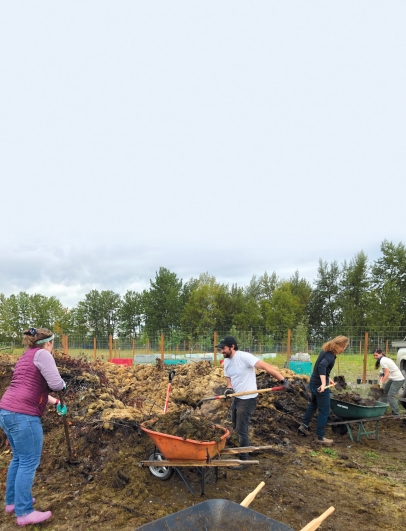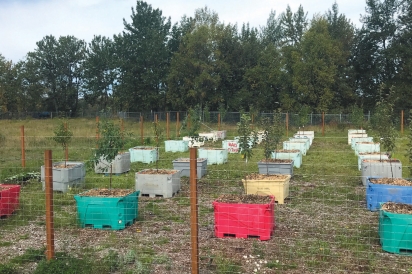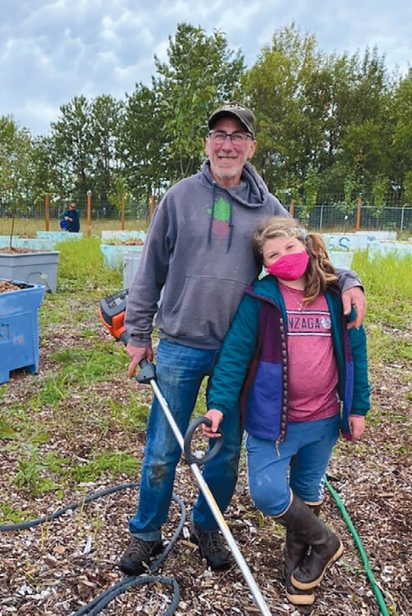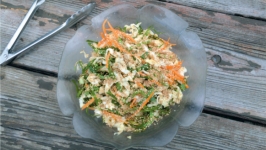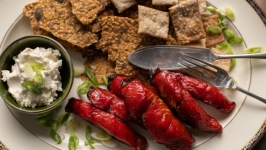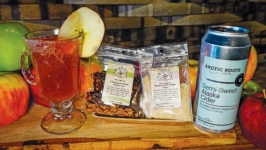Stickleback Farm: Moving Forward Together, as a Stronger Community
By Evie Witten, With Contributions From Danny Consenstein, Micah Hahn, And Liz Snyder
If you drive past the large vacant lot between Ingra and Eagle Streets on Anchorage’s 3rd Avenue, just uphill from Bean’s Café, you might notice windrows of composting wood chips and other organic material snaking along the east end of the property. Beyond those you would see a curious constellation of large, colorful fish totes. Then, if you look closely, you might catch a glimpse of small fruit trees poking out of each tote, with an identifying tag hanging from each slender stem. At first glance it may be difficult to imagine, but what you’re looking at is an emerging urban farm, one that’s been five years in the making, and one that aims to help transform this downtrodden corner of the city into a vibrant neighborhood enlivened by state-of-the-art Northern food production.
Named Stickleback, after the resilient small fish found in neighboring Ship Creek, the nascent farm is slated to occupy about two acres of the 15-acre parcel, as part of a vital urban mixed-use development. Stickleback Farm is an agrihood, a development where agriculture is intentionally included. The farm’s mission is to demonstrate how high-density, sustainable fruit and vegetable production designed specifically for our cold, short growing season can supply produce for some of Anchorage’s least food secure neighborhoods, while also providing job training opportunities for youth and other transitioning populations. The hands-on approach is nested in a broader vision, which arose through the collective effort of diverse groups in Anchorage: to revitalize the long-neglected and highly visible parcel of land while demonstrating how an urban farm can add beauty, bring community together, and help make more healthy foods available.
An Anchorage landmark
Stickleback Farm is taking root where a major Anchorage landmark once stood—the first Alaska Native Service Hospital was built on the site in 1953 to care for Alaska Native people suffering from tuberculosis, a huge epidemic in rural parts of the state at the time. Perched on a bluff overlooking the Ship Creek industrial area, the hospital was originally surrounded by a thriving neighborhood with small homes, businesses, and even a ski jump on the north side. For some Alaska Native community members, it was the place where family members were born and cared for, and where some suffered and passed away. For many, it was a place of trauma. When the current Alaska Native Medical Center opened in the University-Medical District in 1997, the old building was torn down. The large lot sat empty for over 20 years, fenced off and overgrown with alder and weeds. The once tidy and welcoming neighborhood experienced an increasing presence of food pantries, meal centers, shelters, and makeshift encampments of the city’s unhoused population.
In 2017, Anchorage Assembly Member Christopher Constant recognized an opportunity: the community could address local needs by building on the site’s assets, including its flat land and proximity to nearby social services. Constant reached out to the Alaska Food Policy Council (AFPC) and the University of Alaska Anchorage (UAA), and together they began promoting the idea of revitalizing the neighborhood with food system-based economic and social development. The city’s Heritage Land Bank, which manages the property, initiated a public planning process and began making significant contributions of regulatory support, time, and grant funding. Others joined in, including Alaska Pacific University, Alaska Seeds of Change (SEEDS), the Alaska Native Tribal Health Consortium (ANTHC), Anchorage Museum, and the Third Avenue Radicals, a group of inspired home and business owners dedicated to revitalizing their neighborhood. The U.S. Department of Agriculture and the Environmental Protection Agency supported the planning efforts with a Local Food/Local Places grant.
After many community meetings, one zoning change, and several interim use permits, the first pieces of the farm came together in 2019 and 2020. The Heritage Land Bank helped secure access to water, the ANTHC provided Conex boxes for tool storage, the AFPC and Seeds of Change partnered to erect a moose fence, and AFPC volunteers launched a Kickstarter campaign to purchase soil and lumber for raised beds. The day they built the beds, curious people stopped by to ask questions. A neighbor asked if he could help, picked up a hammer, and spent hours banging nails. That was a confirming moment, proof that that teaching about urban farming could help renew the site. Small steps could add up and the community would rally around the idea.
A bridge from trauma to regeneration
On a sunny July morning in 2021, a small crowd gathered to cleanse and bless the land at 3rd and Ingra with ceremony to honor and respect the many Alaska Native and American Indian people who experienced significant life events at the former hospital. Meda DeWitt, a Lingít traditional healer, held space to acknowledge past hurts, honor blessings, and help bring healing, understanding, and transformation to the site. It was a powerful step toward integrating the land’s history with the vision of a progressive urban development project.
Containerized orchard—Stickleback Farm’s movable feast
The fish tote orchard, planted by community volunteers on a blustery day in September 2021, is the farm’s first living asset. Twenty-eight apple and five sour cherry trees set in soil-packed, recycled fish totes will grow as part of an experiment in establishing a cold-hardy urban orchard. Funded by a grant from the Alaska Department of Natural Resources’ Division of Forestry, the orchard is a long-term investment, and because the trees are planted in containers, it’s flexible. The project allows the farm to take root in a way that tests a novel approach and while volunteer crews build compost that will enrich and soften the hard-packed urban soil, readying it for other crops.
Alaska Seeds of Change, which runs an indoor hydroponic farm in Spenard as part of a workforce development program for at-risk youth, is taking over long-term management of the orchard. Further growth of Stickleback Farm, including more detailed farm planning and fundraising efforts, will remain collaborative. SEEDS is poised to take the lead on the ground with its focus on mental health, hands-on training, and farming expertise.
Stickleback Farm is unique—not a community garden
Anchorage is fortunate to have several community gardens, plus Grow North Farm, an incubator site hosting individual, mostly immigrant farmers in Mountain View. Stickleback’s goals are different. Leveraging the high visibility of the site, the farm is focused both on teaching transferable, on-the-ground skills and on demonstrating at the community level how we can grow ample, nutritious food in our northern city. Finally, it shows that a place that once held trauma can become a place of regeneration and hope.
Moving forward together, as a stronger community
If you drive up 3rd Avenue in five years, you should see a vital urban farm nestled into the new neighborhood of homes and shops. You will notice cold-hardy crops thriving in beds of healthy soil, high tunnels sheltering warmth-seeking plants, and perhaps a small solar array helping to power the facilities. The orchard trees will be six feet tall and bearing fruit. Murals painted by Alaska Native artists will grace the Conex storage sheds. Young people will work the land, gaining valuable skills, and sharing information about climate-smart agriculture with rural peers. A place that once held trauma for many will be a place of unity, regeneration, and hope, transformed around a common goal for greater food security and catalyzed by the vision and work of diverse members of the community.
Published in Edible Alaska's issue 24, Summer 2022.


